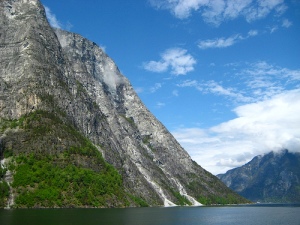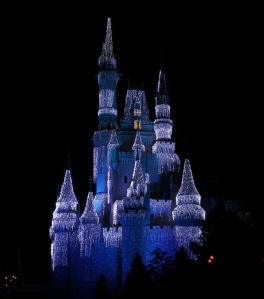Mary Wollstonecraft: A Vindication of the Rights of Woman
 And so here we are: the final book of the year and the last post of this blog. And what better way to round off this canter through some of the highlights of women’s lit past and present than to leapfrog back a few centuries to one of the early trailblazers?
And so here we are: the final book of the year and the last post of this blog. And what better way to round off this canter through some of the highlights of women’s lit past and present than to leapfrog back a few centuries to one of the early trailblazers?
Memories and attention spans being what they are, we have a tendency to think that we, or at a stretch the generation before us, invented most of the big ideas. From sexual intercourse beginning in 1963 to the term ‘wireless’, we congratulate ourselves on working it all out pretty much from scratch.
When it comes to feminism, we can be particularly smug. Alright, so we vaguely remember the suffragettes. But they were a bit quaint and genteel with their high-necked dresses and bustles, weren’t they? Really the whole thing only kicked off with Germaine Greer and after that, well, it all went a bit quiet. In fact it’s only in the last year or so with sheroes like Kat and Caitlin showing us how to be women that feminism has truly got off the ground.
Well, not quite. And there are few texts more qualified to show up the flaws in such short-termism than Mary Wollstonecraft’s A Vindication of the Rights of Woman.
Published in 1762, the text sets out Wollstonecraft’s arguments against the marked inequality she sees between men and women at all levels in society. This, she claims, stems from a ‘false system of education’, which prizes ‘delicacy’ above all other traits in women, denying them the opportunity to develop their talents and interests in a meaningful way, and encouraging them to focus all their attention on being attractive objects for men to amuse themselves with. Given such an education, she writes, is it any wonder that women’s ‘minds are not in a healthy state’?
From this she proceeds to set out her stall for a new and better system of education that would enable women to develop their faculties and reasoning on the same footing as men, and give them the opportunity to take up independent positions and responsibilities in society. Give us a chance, she argues, and if it turns out we’re no good at it, at least you’ll have solid proof of women’s inadequacies rather than mere conjecture.
Writing from personal experience and observation, Wollstonecraft includes many anecdotes to illustrate her points. Inevitably, some of her own bugbears creep in, lending the text an occasionally quirky air. The observations on the indecency of women changing in the same room as each other and the frivolity of reading novels, for example, are products of Wollstonecraft’s time and taste, rather than central planks of the argument, but they lend the book some welcome colour.
Readers with any knowledge of more recent feminist literature will be struck by the amount that Wollstonecraft anticipates. From observations on the way men ‘inwardly despise’ women, foreshadowing Greer’s comments nearly 200 years later, to compelling arguments against gender-specific toys that might have been made by Kat Banyard, Wollstonecraft repeatedly sets out arguments that will be rehearsed over centuries to come. Even her reflections on the generations it is likely to take for true equality to take root find their echo in Marilyn French, Greer and Caitlin Moran.
But perhaps most striking of all, is the point that Wollstonecraft leads with in her introduction: that inequality stems from a tendency to ‘consider females as women rather than human creatures’. Having spent a year reading women writers, this seems to me to be the problem facing women authors these days too. Until we get past the stage of thinking of books by women as a sort of sub-set of literature proper and realise that they are every bit as diverse, compelling, complex and vital as those by men (as I hope this blog has gone some small way to showing), women will continue to be under-read and under-published and intelligent young women will continue to regard books by their contemporaries as somehow lesser.
Wollstonecraft was on to this more than two centuries ago. Isn’t it time the rest of us caught up?
Thanks to everyone who has followed and commented on this blog over the past year, and to all those who have suggested books. It’s been a great pleasure and privilege to have your support. If you’ve enjoyed what you’ve read (or even if you haven’t), please join me on my next adventure. I’d really appreciate your help.
Best wishes for 2012.
Sigrid Undset: Kristin Lavransdatter (trans. Tiina Nunnally)
 Now and then someone recommends a book to me and my heart sinks. It might be that the title sounds naff. Or that the author is someone I’ve made a vow never to read. The genre might be the problem (as regular visitors to this blog know, magical realism and I have a largely hate-hate relationship), or the subject matter.
Now and then someone recommends a book to me and my heart sinks. It might be that the title sounds naff. Or that the author is someone I’ve made a vow never to read. The genre might be the problem (as regular visitors to this blog know, magical realism and I have a largely hate-hate relationship), or the subject matter.
In the case of Norwegian Nobel-Prize-winner Sigrid Undset‘s Kristin Lavransdatter, it was the 1,100-plus page count that had me gnawing my knuckles in dread.
Now, as anyone who’s seen my plans to read the world in 2012 knows, I’m not afraid of a challenge. It’s simply that on balance I prefer novels to look like books rather than doorstops. So when this three-volume beast thunked on to the mat, it took me a good while to work up the enthusiasm to open it and have a read.
But, oh, am I glad I did because, quite simply, and with no qualifications of any kind, this is one of the best books I have read in my life.
Set in fourteenth century Norway (I know, it’s not a promising start, but stick with it), the 1920s trilogy follows the life of noblewoman, Kristin Lavransdatter. The narrative keeps largely to the estates and convents at which she lives, yet this is no period kitchen-sink drama: kicking sand (or perhaps Scandinavian snow) in the face of all those who maintain that women’s lit is narrow and homely in scope, Undset uses the domestic as a prism through which to view national and international events.
In this, the book shares ground with Mantel’s Wolf Hall, but, as the protagonist is female and, as such, not privy to the machinations of the kingmakers as Mantel’s hero is, Undset’s achievement is all the more impressive.
Impressive, too, is Undset’s knowledge of the period in which her story is set. This is evident in everything from the detailed descriptions of rituals around events from births, through the preparation of the marriage bed and the last rituals of dying right down to her choice of similes. These are consistently faithful to the setting and yet fresh and memorable for the modern reader — for example, when Kristin is only able to glimpse her lover from a distance at convent services, she is described as feeling like ‘a hawk that sat chained to a roost with a hood pulled over its eyes’.
Yet what brings all this alive is Undset’s feeling for the characters and world she has evoked. Instead of a cold procession of historical and anthropological details, we are presented with a vibrant milieu, peopled with beings riddled with faults and contradictions. What comes home again and again over the course of the epic is its author’s insight into and sympathy for humanity and her awareness of the cruel conspiracy of character and circumstance that drives people off the course they would have wanted for their lives and yet enriches existence.
The upshot of this is a cast of characters with whom we feel and live through events (when Kristin’s father Lavrans died, I cried my eyes out on the tube — apologies if you were riding in the same carriage), and it makes for a book that is without question among the greatest works in the world. If I hadn’t already read it, I would be recommending it to myself for next year, regardless of its length.
Thanks to Jason Cooper for the recommendation.
Picture by jimgrant
Marilynne Robinson: Gilead
 Preachers tend to get a bad press in literature. From bumbling buffoons like Jane Austen’s Mr Collins through to Hilary Mantel’s sinister and erratically cruel Cardinal, it’s clear that there is not much love lost between many wordsmiths and the Church.
Preachers tend to get a bad press in literature. From bumbling buffoons like Jane Austen’s Mr Collins through to Hilary Mantel’s sinister and erratically cruel Cardinal, it’s clear that there is not much love lost between many wordsmiths and the Church.
Much of this is no doubt justified by the countless instances of abuse of trust and power, not to mention downright idiocy, bodied forth in pulpits around the world across the centuries. Nonetheless, it was surprisingly refreshing to find an alternative perspective in Marilynne Robinson’s Pulitzer Prize-winning Gilead.
Set in 1957, the novel is gathered together out of the final writings, recollections and pensees of the Reverend John Ames, a pastor in the two-horse town of Gilead in America’s Midwest. Aware that death is approaching fast and that he will not live to see his young son grow up, the old man sets about writing an extended letter that he hopes will explain something of his history, life and belief system to his child in years to come.
It sounds like a recipe for a huge helping of mawkish sentimentalism. And yet it absolutely isn’t. Instead, Robinson uses a talent for transfiguring the mundane to create a monument to the beauty of the human spirit and the honest attempt to seek out and remain faithful to truth, whatever it may be.
It’s a novel built on moments. The fragmentary nature of the narrative allows Ames to dwell on particular instances, imbuing them with significance because of the way he remembers them. The best of these have a poetic lyricism, backlit by Ames’s certainty about their eternal significance, which offers readers of any religious persuasion and none a compelling insight into the alchemy of faith.
Ames could be a prig, but he isn’t. Suspicious of the shiftless Jack Boughton, who he fears may have designs on his much younger wife, Ames wrestles with his own jealousy and paranoia, deceiving and rebuking himself by turns. He also loves life with a fierce passion that breaks through the measured prose, full of joy, wistfulness and poignancy: ‘Oh, I will miss the world!’ he exclaims in the middle of an anecdote.
This, coupled with Robinson’s excellent eye for awkwardness, and an impeccable interweaving of scripture, gives the narrative a richness and humanity guaranteed to sweep the reader along. I doubt there are many who make it through the final quarter without shedding a tear.
Picture by Pam’s Pic-‘s
Miriam Toews: Irma Voth
 Of all the book bloggers out there (and there are quite a lot of us), there are few more established and respected than the Dovegreyreader. Prolific yet discerning, this Devon-based woman of letters tears through books at the rate that most of the rest of us Brits go through cups of tea.
Of all the book bloggers out there (and there are quite a lot of us), there are few more established and respected than the Dovegreyreader. Prolific yet discerning, this Devon-based woman of letters tears through books at the rate that most of the rest of us Brits go through cups of tea.
So when I read that Miriam Toews was one of the Dovegreyreader’s favourite writers, it seemed obvious to include Toews’s latest novel on my list of books by women writers for this year.
Set in the arid plains of Mexico, the novel draws on Toews’ own Mennonite background to provide a portrait of a young woman struggling to build an identity for herself after she is shunned by the closed and traditional community in which she was raised. When a film crew comes to shoot near her home, Irma Voth finds herself caught up with a crowd of people who think and act in ways she has never experienced before and begins a journey that will lead her to question and confront the rules and memories that have held her captive.
I can see why the Dovegreyreader rates Toews. Packed with striking insights and unusual perspectives, Toews’s writing is at once powerful and delicate. On the surface, nothing very much happens for long stretches of this novel, but the narrative is alive and thrilling, feeding off Irma Voth’s sublimated fury and grief and the thousand thoughts and impressions that make the wilderness sing.
Toews is one of the best writers of dramatic irony I have ever read. Time and again, she sets up and plays out misunderstandings that the reader can see through before the character does, wringing a great deal of tension and poignancy from her scenes in the process.
It’s a tough book, but it’s not without humour. Drafted in to translate for the German Mennonite actress, Voth finds herself getting creative with the script, so that the words the character says are often a wry comment on the male-authored script (as well as an expression of Voth’s fears and desires).
The book also yielded the second description I have come across this year of a woman embroidering secret, subversive messages into clothes (the first was in Siri Hustvedt’s The Summer without Men). I’m not sure if anyone has made a study of subversion and sewing in women’s literature, but it seems that this might be a rich seam for inquiry (if you’ll pardon the pun).
There were one or two moments that felt slightly contrived – particularly some of the more philosophical pronouncements from the film director Diego and the revelation of the fate of Voth’s father at the end. All in all, though, this was an engrossing read that managed to illuminate a little-known way of life without any of the voyeurism usually attached to such works. Highly recommended.
Picture by crowderb
Mary Stewart: Wildfire at Midnight
 Every now and then you are introduced to a writer (thanks stuartblessman) who you can’t believe you’ve managed to get so far through life without discovering. Such a one for me is Mary Stewart, the English popular novelist famed for knitting together the romance and mystery genres (and author of the Merlin trilogy), who was awarded an honorary doctorate by Durham University in 2009 for her lifetime’s work.
Every now and then you are introduced to a writer (thanks stuartblessman) who you can’t believe you’ve managed to get so far through life without discovering. Such a one for me is Mary Stewart, the English popular novelist famed for knitting together the romance and mystery genres (and author of the Merlin trilogy), who was awarded an honorary doctorate by Durham University in 2009 for her lifetime’s work.
Advised to read ‘pretty much anything’ by her, I picked out Wildfire at Midnight on the strength of Amazon’s breathless blurb about ritualistic murders and webs of fear and suspicion (I am not nearly as high-minded as I sometimes like to think).
Stewart did not disappoint. Sweeping me along with her heroine Gianetta, a recent divorcee and former model still in her early twenties, she immersed me in her deliciously nostalgic scene setting, homing in on a lonely hotel on the Isle of Skye where a large cast of characters is struggling to come to terms with the sacrifice of a crofter‘s daughter up on the neighbouring mountain.
What I hadn’t expected was how funny Stewart would be. Easy and conversational, her narrative style is peppered with jokes and gentle swipes at the idiosyncrasies of many of her creations, while losing none of the suspense required to make the story work. Reading her at her best is like reading Agatha Christie with a healthy dollop of Nancy Mitford stirred in.
There are one or two blots on the copybook though: the plot relies on a series of apparent coincidences that bring a lot of people who know each other together in a remote location, straining credulity early on (although some of this is later explained away), and the whole thing turns on Gianetta’s adherence to a rather quaint moral code, which although attributable to her Roman Catholic background is not adequately explained for the modern reader to buy into wholesale.
I could also have lived without a few of the more unfortunate turns of phrase: it will be a while before I manage to get the thought of ‘the excited hands of the butcher coming behind me’ out of my head.
However, much of this is probably down to the fact that Wildfire at Midnight was only Stewart’s second book and it doesn’t take away from how downright enjoyable the experience of reading her is. It would be interesting to see how Stewart’s style and the moral universe of her characters shifted as her career progressed. Doubtless I’ll be back for more.
Photo by Y Ballester
Maile Chapman: Your Presence is Requested at Suvanto
 There can be few ancient Greek tragedies more disturbing than Euripides’ The Bacchae. Building to the cataclysmic scene in which the possessed women of Thebes tear their kinsman Pentheus limb from limb, it packs a serious punch and continues to be lauded by critics who hail it variously as a comment on the dangers of fundamentalism, a parable of excess, and a portrait of the dark desires that seethe within us all.
There can be few ancient Greek tragedies more disturbing than Euripides’ The Bacchae. Building to the cataclysmic scene in which the possessed women of Thebes tear their kinsman Pentheus limb from limb, it packs a serious punch and continues to be lauded by critics who hail it variously as a comment on the dangers of fundamentalism, a parable of excess, and a portrait of the dark desires that seethe within us all.
This sinister ambiguity is something that US writer Maile Chapman harnesses in her excellent first novel, Your Presence is Requested at Suvanto. It is set in a sanatorium in the eerie fringe world of northern Finland and follows a group of women caught somewhere between health and madness as they encounter, battle, and ultimately enact urges and feelings that the world does not allow them to express.
Events move slowly, yet, like the water shifting beneath the thick ice that forms as the sunless winter sets in, emotions stir beneath them, giving a dizzying significance to the catalogue of petty grudges and trivial incidents that the book records. This is heightened by the butterfly narrative, which flits from mind to mind, picking up the pitiful memories of Nurse Sunny here, the sexual trauma of her patient Julia there, and the thousand paranoid impulses, peeves and preoccupations that clutter the consciousnesses of the people who inhabit this halfway house between oblivion and the world.
At first, this can be frustrating as you struggle to catch on to concrete details about the characters that form, merge and mutate before your eyes. But Chapman knows what she’s doing: out of the mist of sensations and impressions a weird, collective consciousness forms that is at once everyone and no-one portrayed and that drives the plot through to its ghastly conclusion.
Reading the work, you become uncomfortably aware that yours is the mind in which its events are playing out. When the depths of the winter pass and the narrative draws to a close, you put the book down with awe, unease and, yes, a faint twinge of guilt.
Picture by Numinosity
Diana Wynne Jones: Howl’s Moving Castle
 You’d have to have been taking part in a three-year BBC 4 social documentary recreating the living conditions of 18th century crofters not to have picked up on the YA hype that’s been going around lately. Young adult fiction (just in case you are still struggling out of your smock) is massive and, as one literary agent tweeted breathlessly from the Frankfurt Book Fair last month, even publishers who would never have dipped their toes into the teen lit market before are crying out for dystopia, fantasy, werewolves and vampires.
You’d have to have been taking part in a three-year BBC 4 social documentary recreating the living conditions of 18th century crofters not to have picked up on the YA hype that’s been going around lately. Young adult fiction (just in case you are still struggling out of your smock) is massive and, as one literary agent tweeted breathlessly from the Frankfurt Book Fair last month, even publishers who would never have dipped their toes into the teen lit market before are crying out for dystopia, fantasy, werewolves and vampires.
Bloggers are on to it too. In fact many of the comments and feedback I’ve had for this site have involved recommendations of YA books to read. And one name has cropped up again and again: Diana Wynne Jones.
Published in 1986, one of the English writer’s most famous novels Howl’s Moving Castle has been reaping the benefits of the YA surge. Set in the magical kingdom of Ingary, it follows Sophie Hatter as she sets out to seek her fortune in the wake of being turned into an old woman by the Witch of the Waste. Sophie is thrown on the mercy of Wizard Howl, whose moving castle has been menacing her town, and who has a nasty reputation for sucking out the hearts of young girls. But of course nothing is quite as it first appears and before long she is striding around the country in seven league boots, casting all sorts of spells in an effort to defeat the witch and return Ingary to its happily ever after.
So far, so conventional. What lifts the narrative out of its fairytale formula, though, is the wit and verve with which Jones sets out her stall. We hear that magical folk only wear cloaks and buckled boots on festival days and would never dream of putting them on for work, and that ‘it is quite a risk to spank a wizard for getting hysterical about his hair’. And when Sophie makes it through the castle’s mysterious black exit to the weird land of Wales (where the provenance of Howl’s name — Howell — suddenly becomes clear) her response to cars and computers is a joy to read.
I loved it. But one of the things I loved most about it was how familiar it felt. Far from being part of a brave new genre, this book took me back to the children’s stories I got from my Mum’s collection — forgotten classics such as Marion St John Webb’s The Little Round House (London, 1956), which, for all their political incorrectness, managed to spin engrossing yarns with wit and clever observations layered on top.
Judging by Wynne Jones, I couldn’t help wondering whether YA fiction is simply what used to be thought of as good children’s lit. And if, instead of creating a magical new genre, publishers have simply shrunk childhood and pulled off the greatest marketing trick of the 21st century to date.
Picture by laserbub
Heather Peace: All to Play For
 I first met Tom Chalmers six years ago when I went to interview him about his bold decision to launch his own publishing company at the age of just 25. It was the dawn of the mass-market e-book era, independent bookshops were folding like origami and the only works that mainstream publishers seemed interested in selling were ‘autobiographies’ by celebrities with one-word names. Watching Chalmers launch his plucky little list of Legend Press print titles on to the turbulent waters of the book trade felt like witnessing someone begin an attempt to row round the world in a bath tub: it was daring, intrepid and more than a bit mad.
I first met Tom Chalmers six years ago when I went to interview him about his bold decision to launch his own publishing company at the age of just 25. It was the dawn of the mass-market e-book era, independent bookshops were folding like origami and the only works that mainstream publishers seemed interested in selling were ‘autobiographies’ by celebrities with one-word names. Watching Chalmers launch his plucky little list of Legend Press print titles on to the turbulent waters of the book trade felt like witnessing someone begin an attempt to row round the world in a bath tub: it was daring, intrepid and more than a bit mad.
So it was great to bump into Tom in a pub a couple of weeks ago and hear that, in spite of all the squalls, twisters and hurricanes buffeting the literary market in recent years, Legend Press continues to go from strength to strength. I was also intrigued to hear that, since taking on a female member of the editorial team, the list has incorporated more women’s lit, and was only too pleased to take up Tom’s offer of sampling one of the latest titles.
Judging by Heather Peace’s All to Play For, the company is in very good shape indeed. Ambitious and wide-ranging, this insider’s portrait of the BBC (Peace was a script editor in the corporation for much of the early-mid nineties) charts the careers of a group of misfits and megalomaniacs as they struggle to carve out a career in television in the face of cuts, political pressures and vicious micro-management.
At its very best, it feels as though Peace has snuck you past security at Television Centre and given you carte blanche to wander in and out of production meetings and scheduling sessions, rummaging through people’s desk drawers as you go. This is made even better by the fact that Peace clearly has an axe or two to grind about some aspects of the Beeb in the nineties and combines this with an ability to draw a range of compelling, believable characters to body forth her peeves in glorious Technicolor.
That said, the book could have done with some tighter editing. Rants on David Cameron’s government, the youth of today and the challenges of writing a novel can make you feel as though you’ve been cornered by someone’s verbose uncle at a party when you’re itching to talk to the more interesting people in the room (of which there are many). Unless you’re Nabokov writing Pale Fire, phrases such as ‘I’m rambling’ and ‘sorry if I’m labouring the point’ are usually a cry for the pruning shears.
Overall, though, in the best traditions of BBC scheduling, this is a highly enjoyable spread of light entertainment and cultural commentary with some moments of high drama thrown in. I found myself thinking about it when I wasn’t reading it and looking forward to the hour I could spend with it on the tube. Congratulations to Peace and Legend Press. More please.
Picture by I-b-p-2011
Carol Birch: Jamrach’s Menagerie
 This year’s Booker Prize brought out the best and the worst of the UK literati. The best was the long-awaited triumph of Julian Barnes, thrice the bridesmaid but never before the bride, for The Sense of an Ending (which I haven’t read yet, owing to my women-only diet, but should be a worthy winner if his previous efforts are anything to go by).The worst was a maelstrom of barracking and back-biting about the shortlisting and judging process, centring around the issue of readability versus quality.
This year’s Booker Prize brought out the best and the worst of the UK literati. The best was the long-awaited triumph of Julian Barnes, thrice the bridesmaid but never before the bride, for The Sense of an Ending (which I haven’t read yet, owing to my women-only diet, but should be a worthy winner if his previous efforts are anything to go by).The worst was a maelstrom of barracking and back-biting about the shortlisting and judging process, centring around the issue of readability versus quality.
The pity of it was that the debate shifted the focus away from the shortlisted novels, many of which were controversial and intriguing works in their own rights — none more so than Carol Birch‘s 11th novel, Jamrach’s Menagerie. Set in the 19th century, the book weaves together two historical happenings — an escaped Bengal tiger’s brush with an eight-year-old boy in Victorian London and the shooting of a teenager sailor by his childhood friend after drawing straws — into a rich and wide-ranging adventure.
Told through the eyes of young Jaffy Brown, who takes to sea in search of a real-life dragon wanted for a wealthy client’s collection, the story has an episodic, almost picaresque feel to it. However, unlike many picaresque novels, in which writers often struggle to stitch substance into sensational tales of derring do, the novel brims with meaning and insight. Birch achieves this through her attention to detail and the fresh vision she brings to each scene. Thanks to her skill, even the ragged finger nails of a street urchin take on a compelling quality, while the chaotic shop and menagerie of the kindly Jamrach are heady, enchanting creations.
But the crowning achievement comes when calamity strikes and Jaffy and is shipwrecked. Cast adrift in lifeboats for a good 100 pages or so, the motley band is pushed to the limits of existence and forced to taste the dregs of mortality (and each other).
A huddle of characters bobbing around on the ocean with nothing to do except butcher and eat those who die every now and again sounds like a commissioning editor’s nightmare, but in Birch’s hands it is subtle, compelling and disturbingly visceral. I’ve never eaten human flesh (shock admission, I know), but after reading this book I feel as though I can still taste it.
Should Birch have been shortlisted for the Booker Prize? Was this one of the six best books published this year? I don’t know. Perhaps the plot is a little simplistic and linear. Maybe the later part of the book could have done with an edit or two more. To be honest, I don’t really care.
Whether it deserved the accolade or not, this is an exceptionally good book that whips along at a cracking pace, engrossing the reader in a world sturdy enough to bear the weight of some deep insights into what it means to be a member of humanity. Quality and readability combined. Who’d have thunk it?
Picture by Monceau
